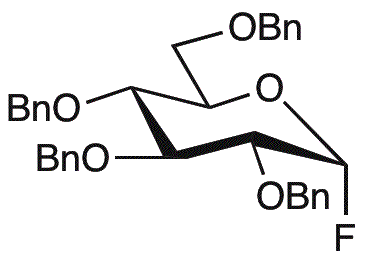2,3,4,6-Tetra-O-benzyl-a-D-glucopyranosyl fluoride is widely utilized in research focused on:
- Synthetic Chemistry: This compound serves as a versatile building block in the synthesis of complex carbohydrates, enabling researchers to create tailored glycosides for various applications.
- Pharmaceutical Development: It is used in the development of glycosylated drugs, which can enhance bioavailability and specificity, particularly in targeting certain cell types.
- Biotechnology: The compound plays a crucial role in the modification of biomolecules, aiding in the design of glycoproteins and other bioconjugates for therapeutic use.
- Analytical Chemistry: It is employed as a reagent in the analysis of carbohydrate structures, facilitating the identification and characterization of glycosylation patterns in various samples.
- Food Industry: This chemical can be utilized in the synthesis of sweeteners and flavor enhancers, providing a means to create more complex and appealing taste profiles in food products.
General Information
Properties
Safety and Regulations
Applications
2,3,4,6-Tetra-O-benzyl-a-D-glucopyranosyl fluoride is widely utilized in research focused on:
- Synthetic Chemistry: This compound serves as a versatile building block in the synthesis of complex carbohydrates, enabling researchers to create tailored glycosides for various applications.
- Pharmaceutical Development: It is used in the development of glycosylated drugs, which can enhance bioavailability and specificity, particularly in targeting certain cell types.
- Biotechnology: The compound plays a crucial role in the modification of biomolecules, aiding in the design of glycoproteins and other bioconjugates for therapeutic use.
- Analytical Chemistry: It is employed as a reagent in the analysis of carbohydrate structures, facilitating the identification and characterization of glycosylation patterns in various samples.
- Food Industry: This chemical can be utilized in the synthesis of sweeteners and flavor enhancers, providing a means to create more complex and appealing taste profiles in food products.
Documents
Safety Data Sheets (SDS)
The SDS provides comprehensive safety information on handling, storage, and disposal of the product.
Product Specification (PS)
The PS provides a comprehensive breakdown of the product’s properties, including chemical composition, physical state, purity, and storage requirements. It also details acceptable quality ranges and the product's intended applications.
Certificates of Analysis (COA)
Search for Certificates of Analysis (COA) by entering the products Lot Number. Lot and Batch Numbers can be found on a product’s label following the words ‘Lot’ or ‘Batch’.
Numéro de catalogue
Numéro de lot/série
Certificates Of Origin (COO)
This COO confirms the country where the product was manufactured, and also details the materials and components used in it and whether it is derived from natural, synthetic, or other specific sources. This certificate may be required for customs, trade, and regulatory compliance.
Numéro de catalogue
Numéro de lot/série
Safety Data Sheets (SDS)
The SDS provides comprehensive safety information on handling, storage, and disposal of the product.
DownloadProduct Specification (PS)
The PS provides a comprehensive breakdown of the product’s properties, including chemical composition, physical state, purity, and storage requirements. It also details acceptable quality ranges and the product's intended applications.
DownloadCertificates of Analysis (COA)
Search for Certificates of Analysis (COA) by entering the products Lot Number. Lot and Batch Numbers can be found on a product’s label following the words ‘Lot’ or ‘Batch’.
Numéro de catalogue
Numéro de lot/série
Certificates Of Origin (COO)
This COO confirms the country where the product was manufactured, and also details the materials and components used in it and whether it is derived from natural, synthetic, or other specific sources. This certificate may be required for customs, trade, and regulatory compliance.


